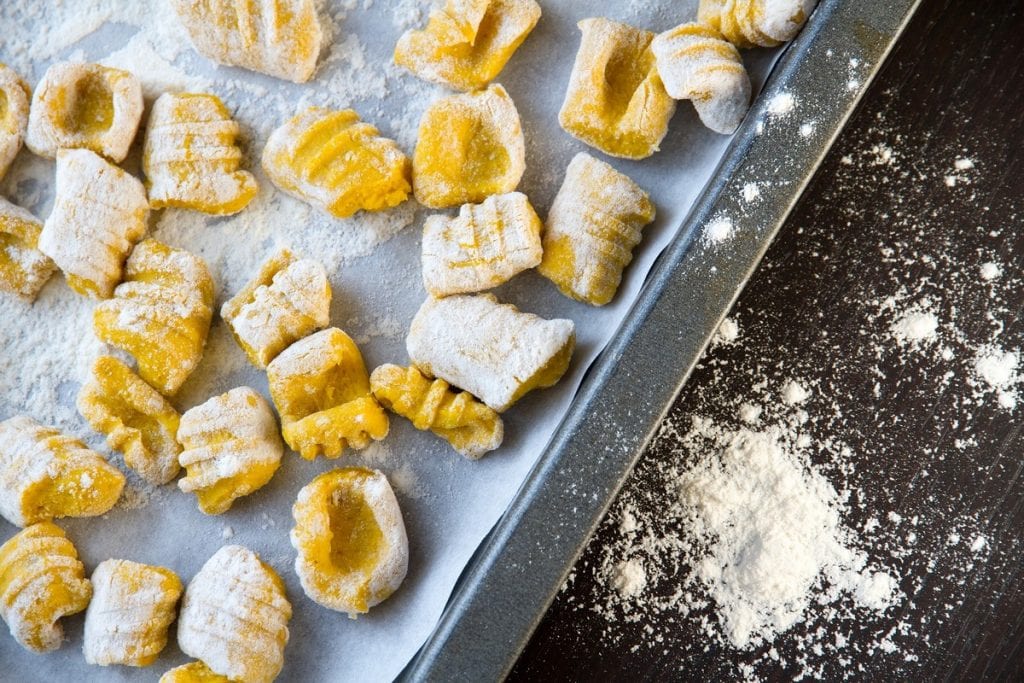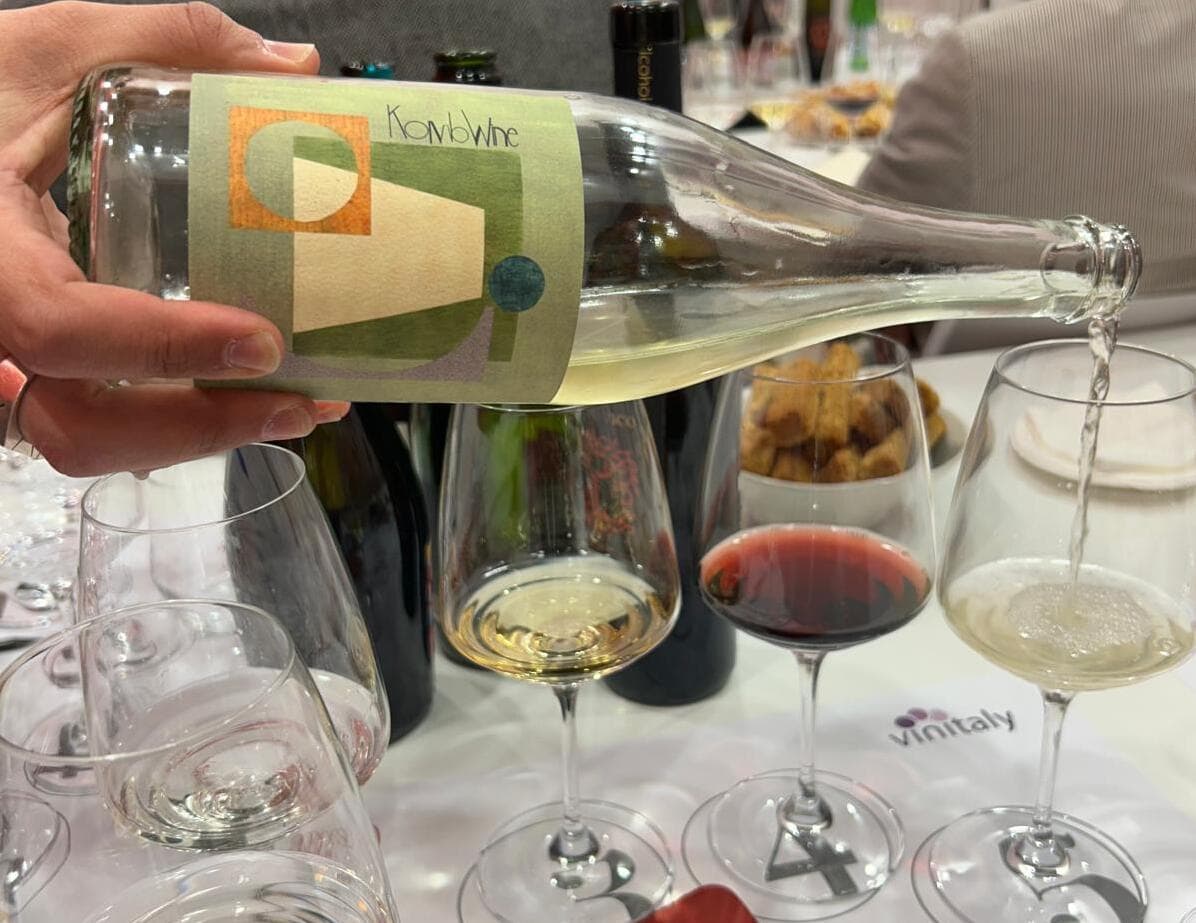Origin of gnocchi and Italian variants
When we talk about gnocchi in Italy we immediately think of potato gnocchi. Topped in many ways, depending on the gastronomic habits of the area: with tomato sauce, with meat sauce, basil pesto, cheese fondue, with tomato and mozzarella or simply with brown butter and sage. However, even if they are the best known, gnocchi made with potatoes are not the only ones and not even the original ones: the advent of tubers in Europe required centuries of history, but already the Romans used to mix water and flour to form balls which were then cooked in boiling water. A primordial version of gnocchi, whose name derives from the Lombard term of the medieval era knohha, or “knot,” used to indicate any round ball of dough. The origins of this pasta shape are disputed between different territories and the regional variations are manifold. Here are some examples.
Italian gnocchi recipes
Semolina gnocchi “alla romana”
"Thursday gnocchi, Friday fish or chickpeas and cod, Saturday tripe," according to the Roman cuisine calendar: even today in many traditional taverns diners find gnocchi in the menu only on Thursdays, both in the classic version and in the regional version made with semolina. This mixture is prepared by pouring semolina flour into hot milk and cooking it without forming lumps. Once ready, cooks spread the mixture one centimetre thin on a baking sheet, and let it set for an hour. After the base has solidified, discs are formed with a cookie cutter; these dovetailed in a baking pan and baked in the oven with butter and grated cheese. The result is a sort of timbale au gratin, enjoyed hot with a generous sprinkling of grated Parmigiano (sometimes gnocchi alla romana are also served with tomato sauce). The use of butter and Parmigiano has often created confusion about the origin of the dish: these are, in fact, two elements that are not very common in the Lazio cuisine, which prefers extra virgin olive oil and pecorino cheese, instead. Some gastronomes believe that it may be a recipe of Piedmontese origin, but it's an implausible hypothesis, considering that gnocchi are also mentioned by Pellegrino Artusi in his "Science in the kitchen and the art of eating well." Even Ada Boni in her volume "La Cucina Romana" refers to this specialty as an ancient tradition, to be preserved and safeguarded, "the tradition of a vanished Rome," as she calls it, the dish that the Romans "used to enjoy at every occasion that had the purpose to celebrate something."

Canederli
Gnocchi made of stale bread, flour, eggs, speck, parsley and Parmigiano, also known by the Germanic name knödel and present in almost all of Northern Italy, from Friuli Venezia Giulia to the Alpine areas of Lombardy and Veneto. There are several types, each with different ingredients and proportions, so much so that Felice Libera in his "The art of cooking: recipes for food and desserts, Trentino manuscript of 18th century cooking and pastry" lists more than fifteen. Even earlier, they are mentioned in a late 18th-century cookbook, where they are described as "nudeln pads," dumplings of water and flour boiled in milk and used as a filling for square ravioli, which is then dipped into beaten egg and then fried. The canederli, however, contain all the typical flavours of the high mountains: alpine herbs, cured meats, cheeses, plus mushrooms and broths for seasoning, without forgetting the simple sauce of breadcrumbs browned in butter. They can also be prepared with buckwheat bread and boiled potatoes, or coloured green with spinach. At one time, in Tyrol, "pike canederli" were also a thing, produced with the flesh of fish that's very common in lakes and mountain streams.

Pumpkin gnocchi
Despite being an integral part of the national gastronomic culture, potatoes have not always been present on the Italian table: in fact, it was the Spaniards (and not Christopher Columbus, as often - wrongly - thought) who introduced tubers to Europe importing them from the Andes in the 16th century under the guidance of Francisco Pizzarro, and then the Discalced Carmelite fathers, of the religious order born in Spain, at the end of the 16th century taught Italians to grow and cook potatoes. Before the advent of the product, pumpkins dominated the fillings of fresh pasta, perfect for consistency and storage capacity. In Friuli Venezia Giulia, as well as in Piedmont, pumpkins became part of the dough, together with eggs and flour, a mix of ingredients that gives life to soft gnocchi that are also very popular in the Aosta Valley, where they are baked au gratin and covered with grated fontina.

Gnudi
One of the most popular pasta courses of the Tuscan cuisine are gnocchi made with flour, spinach, chard or other vegetables, ricotta, grated cheese, spices and sometimes even eggs, dredged in flour and boiled in water. Also called malfatti or ravioli gnudi (naked), gnudi are widespread above all in the Val di Chiana and Casentino, in those areas that once had to face greater economic difficulties than the rest of the territory. Among the first to appreciate, Salimbene da Parma, in his "Chronica" of the late 13th century reports having tried them during the feast of Santa Chiara, and then again, in more recent times, Pellegrino Artusi also recommends them as a side dish. In the past, gnudi marked the beginning of spring, the ideal period for ricotta, especially in Papiano, where they were (and still are today) prepared for the feast of Santa Caterina: cooked in large copper pots, the gnocchi make the cooking water greenish in colour, which over time has given rise to the popular saying "if in Stia the water streams down green it means that in Papiano there is a party."

Spätzle
Typical of lower Germany but also very popular in Switzerland, France, Tyrol and Trentino, these are usually served with game or as soup. It's a mixture of wheat flour, buckwheat, water and eggs (to which, sometimes, milk is also added), which is dropped into the broth or salted water through a special tool similar to a flat grater, which gives the typical shape to the gnocchi. There is also a green spinach-based variant, spinatspäztle, traditionally seasoned with butter, cheese and speck, formerly prepared with wild spinach and wild herbs. Ancestors of the spätzle are “bisi di pasta,” which were prepared by pouring the batter from a sieve directly into melted butter, before being sprinkled with cheese and then dipped in broth. Another similar preparation is maneghi de Zuc, whose dough was pressed through a syringe and into the frying butter.
Malfattini
For a long time in some areas of Romagna, hemp was among the most widespread crops. On the occasion of gramolatura, peasant families tried their hand at the preparation of malfattini, small egg gnocchi seasoned with pea sauce or in broth, mixed in a soup with beans. Again mentioned by Pellegrino Artusi, who writes: "The simplest malfattini are made of flour. Mix it with the eggs and knead it with your hands on the pastry board to form a very firm bread: cut it into slices half a finger thick and leave them exposed to the air to dry. Chop them with the half-moon slicer until they are reduced to minute pieces equal to half of a grain of rice, passing them through a small tray to obtain the same, or grate the whole loaf; but do not imitate those who leave them as big as the beaks of sparrows if you do not want them to be difficult for you to digest; indeed, for this reason, instead of flour, you can make simple breadcrumbs, or making them graceful with a pinch of Parmigiano and the smell of spices."

Pisarei
Typical dish of the Emilia peasant tradition, in particular of the province of Piacenza, pisarei are rough-textured gnocchi that are normally eaten in a soup with beans (pisarei e fasò). The dough is a mixture of flour, breadcrumbs and water, from which spaghetti noodles are obtained, and which are then cut into small pieces then pressed down with a finger. Among the most characteristic customs of the past, is the Piacenza mother-in-law who, to judge whether the future daughter-in-law was suitable for their son, used to check the right thumb of the young woman: if it was callused, it meant that she was a good woman of home, because he knew how to make Pisarei well.
Gnocchi recipes
Pumpkin gnocchi
Ingredients
1,2 kg pumpkin pulp
200 g flour
1 egg yolk
Nutmeg
Salt to taste
Chop the pumpkin into wedges and, without peeling it, remove the seeds and filaments and arrange in a pan peel side down. Put it in the preheated oven to 180° C and let it cook for about an hour until tender. Once cooked, let it cool, discard the peel and pass it through a vegetable mill with the finest mesh, dropping the purée into a bowl (if too watery, warm it in a non-stick pan without seasoning to let it dry a little). Add the yolk, almost all the sifted flour, a sprinkling of nutmeg and a pinch of salt. Mix then put the mixture on a floured pastry board and work it as is commonly done with gnocchi. When the dough comes together and becomes smooth, homogeneous and elastic, divide into thirds, rolling each with your hands on the floured pastry board to form a long rope about 1 centimeter in diameter. Cut into small pieces of a couple of centimeters and roll them on the floured board. Do this for all the dough. Form a small groove in each gnocchi by pressing on the prongs of a fork or the back of a cheese grater. When the gnocchi are all ready, boil the water in a large pot and when the water boils, add salt and the gnocchi. Boil them for a few minutes over moderate heat and, when they float up to the surface, fish them out with a skimmer, put them on a serving dish and season to taste. We suggest the classic: butter, sage and parmigiano.
by Michela Becchi


 Versace opens a super hotel with an Italian restaurant. Here's what Donatella Hotel & Restaurant in Miami will be like
Versace opens a super hotel with an Italian restaurant. Here's what Donatella Hotel & Restaurant in Miami will be like At The Crown Tirana, service and quality at the highest levels
At The Crown Tirana, service and quality at the highest levels We tasted Komb(w)ine, the new product that combines grape must and kombucha. Here’s our verdict
We tasted Komb(w)ine, the new product that combines grape must and kombucha. Here’s our verdict What changes for the export of Italian wines to China under the new regulations?
What changes for the export of Italian wines to China under the new regulations? “Forget dealcoholised wines. The future is Komb(w)ine.” Moser and Ravizza present a new grape must-based product
“Forget dealcoholised wines. The future is Komb(w)ine.” Moser and Ravizza present a new grape must-based product






